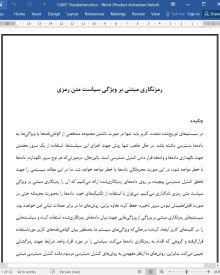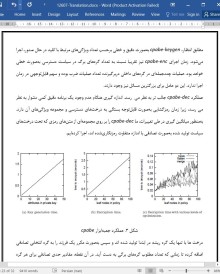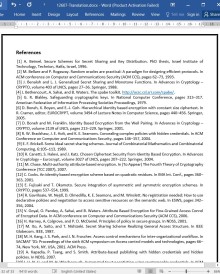
دانلود مقاله رمزنگاری مبتنی بر ویژگی سیاست متن رمزی
چکیده
در سیستمهای توزیعشده متعدد، کاربر باید تنها در صورت داشتن مجموعه مشخصی از گواهینامهها یا ویژگیها، به دادهها دسترسی داشته باشد. در حال حاضر، تنها روش جهت اجرای این سیاستها، استفاده از یک سرور مطمئن جهت نگهداری دادهها و واسطه قرار دادن کنترل دسترسی است. بااینحال، درصورتیکه هر نوع سرور نگهدارندِ دادهها با خطر مواجه شود، در این صورت محرمانگی دادهها با خطر مواجه خواهد شد. ما در این مقاله، سیستمی را جهت تحقق کنترل دسترسی پیچیده بر روی دادههای رمزنگاریشده ارائه میکنیم که آن را رمزنگاری مبتنی بر ویژگی سیاست متن رمزی نامگذاری میکنیم. میتوان با استفاده از تکنیکهای خود، دادهها را بهصورت محرمانه حتی در صورت قابلاطمینان نبودن سرور ذخیره، حفظ کرد؛ علاوه براین، روشهای ما در برابر حملات تبانی امن خواهند بود. سیستمهای رمزنگاری مبتنی بر ویژگی از ویژگیهایی جهت بیان دادههای رمزنگاریشده استفاده کرده و سیاستهایی را در کلیدهای کاربر ایجاد کردند؛ درحالیکه ویژگیهای سیستم ما بهمنظور بیان گواهینامههای کاربر مورداستفاده قرارگرفته و گروهی که اقدام به رمزنگاری دادهها میکند، سیاستی را در مورد افراد واجد شرایط جهت رمزگشایی تعیین میکند. بنابراین، روشهای ما ازنظر مفهومی به روشهای کنترل دسترسی مرسوم مانند کنترل دسترسی مبتنی بر نقش (RBAC) نزدیکتر هستند. علاوه براین، ما پیادهسازی سیستم خود را ارائه کرده و اندازهگیریهای عملکردی خود را نشان میدهیم.
1. مقدمه
در بسیاری از موقعیتهای مختلف، هنگامیکه کاربر دادههای حساسی را رمزنگاری میکند، باید توجه داشت که او سیاست کنترل دسترسی خاصی را بر روی فردی که میتواند این داده را رمزگشایی کند، وضع میکند. بهطور مثال، فرض کنید که نهادهای مبارزه با فساد دولتی FBI در ناکسویل و سانفرانسیسکو در حال بررسی ادعای رشوهخواری نماینده گروه فشار و نماینده کنگره تنسی هستند. عامل رئیس FBI خواستار رمزگشایی اطلاعات و یادداشتهای حساس است بهنحویکه تنها کارکنانی که دارای گواهینامهها و مجوزها یا ویژگیهای خاصی هستند، قادر به دسترسی به این اطلاعات خواهند بود. بهطور مثال، عامل رئیس ساختار دسترسی زیر را جهت دسترسی به این اطلاعات مشخص میکند: AND (“Knoxville” OR “San Francisco”)) OR
(management-level > 5) OR “Name: Charlie Eppes”) ((“Public Corruption Office”.
با توجه به این موضوع، عامل با توجه به این اطلاعات نشان میدهد که یادداشتها باید صرفاً توسط افراد شاغل در نهادهای فساد دولتی در ناکسویل یا سانفرانسیسکو، مسئولین ردهبالای فعال در زنجیره مدیریت سازمانهای FBI و یک مشاور بانام چارلی مشاهده شوند.
همانطور که در این مثال نشان داده شد، باید توجه داشت که فرد دارای مالکیت اطلاعات سری باید قادر به انتخاب یک سیاست دسترسی بر اساس دانش دادههای اصلی باشد. علاوه براین، این شخص ممکن است از هویتهای دقیق کلیه افراد دیگری که باید به دادهها دسترسی داشته باشند، اطلاع ندارد اما ممکن است او راهی را جهت بیان آنها برحسب ویژگیهای توصیفی یا گواهینامهها داشته باشد.
بیشتر روشهای رمزنگاری کلیدی عمومی موجود به یک گروه امکان رمزنگاری دادهها را برای یک کاربر مخصوص فراهم میکنند، اما قادر به مدیریت مؤثر انواع روشهای کنترل دسترسی رمزنگاریشده مانند مثال بالا نیستند.
6. نتیجهگیری و جهت گیری های آزاد
ما سیستمی را برای رمزنگاری مبتنی بر ویژگی سیاست متن رمزی ایجاد کردیم. سیستم ما امکان ارائه نوع جدیدی از کنترل دسترسی رمزنگاریشده را فراهم میکند بهطوریکه کلیدهای خصوصی کاربر بهوسیله مجموعهای از ویژگیها تعیین شده و گروهی که اقدام به رمزنگاری دادهها میکند، قادر به تعیین یک سیاست نسبت به این ویژگیها و تعیین کاربرانی که قادر به رمزگشایی هستند، خواهد بود. سیستم ما امکان بیان سیاستها را بهصورت ساختار دسترسی درختی یکنواخت فراهم کرده و نسبت به حملات تبانی که در آنها ممکن است مهاجم چندین کلید خصوصی را به دست آورد، مقاوم است. درنهایت، ما به بیان روند پیادهسازی سیستم خود شامل چندین تکنیک بهینهسازی پرداختهایم.
میتوان در تحقیقات آینده سیستمهای رمزنگاری مبتنی بر ویژگی را با انواع مختلف قابلیت گویایی در نظر گرفت. هرچند که ABE سیاست-کلیدی و ABE سیاست متن رمزی بهعنوان دو سیستم جالب و قابل تعریف محسوب میشوند، اما قطعا سیستمهای دیگری در این زمینه وجود دارند. چالش اصلی در این تحقیقات، یافتن سیستمهای جدید با فرم های گویایی دقیق است که بیش از یک ترکیب دلخواه از تکنیک ها را ایجاد میکنند.
محدودیت سیستم ما در این مورد است که این سیستم تحت اکتشاف گروهی کلی بهصورت ایمن عمل کرده است. ما معتقدیم که میتوان تلاش های قابلتوجهی را جهت اثبات امن بودن یک سیستم تحت یک فرضیه استاندارد و غیر تعاملی انجام داد. این نوع از تحقیقات حتی در صورت منجر شدن به کاهش کارایی نسبت به سیستم کنونی ما، مفید و جالب خواهند بود.
Abstract
In several distributed systems a user should only be able to access data if a user posses a certain set of credentials or attributes. Currently, the only method for enforcing such policies is to employ a trusted server to store the data and mediate access control. However, if any server storing the data is compromised, then the confidentiality of the data will be compromised. In this paper we present a system for realizing complex access control on encrypted data that we call Ciphertext-Policy Attribute-Based Encryption. By using our techniques encrypted data can be kept confidential even if the storage server is untrusted; moreover, our methods are secure against collusion attacks. Previous AttributeBased Encryption systems used attributes to describe the encrypted data and built policies into user’s keys; while in our system attributes are used to describe a user’s credentials, and a party encrypting data determines a policy for who can decrypt. Thus, our methods are conceptually closer to traditional access control methods such as Role-Based Access Control (RBAC). In addition, we provide an implementation of our system and give performance measurements.
1 Introduction
In many situations, when a user encrypts sensitive data, it is imperative that she establish a specific access control policy on who can decrypt this data. For example, suppose that the FBI public corruption offices in Knoxville and San Francisco are investigating an allegation of bribery involving a San Francisco lobbyist and a Tennessee congressman. The head FBI agent may want to encrypt a sensitive memo so that only personnel that have certain credentials or attributes can access it. For instance, the head agent may specify the following access structure for accessing this information: ((“Public Corruption Office” AND (“Knoxville” OR “San Francisco”)) OR (management-level > 5) OR “Name: Charlie Eppes”).
By this, the head agent could mean that the memo should only be seen by agents who work at the public corruption offices at Knoxville or San Francisco, FBI officials very high up in the management chain, and a consultant named Charlie Eppes.
As illustrated by this example, it can be crucial that the person in possession of the secret data be able to choose an access policy based on specific knowledge of the underlying data. Furthermore, this person may not know the exact identities of all other people who should be able to access the data, but rather she may only have a way to describe them in terms of descriptive attributes or credentials.
Traditionally, this type of expressive access control is enforced by employing a trusted server to store data locally. The server is entrusted as a reference monitor that checks that a user presents proper certification before allowing him to access records or files. However, services are increasingly storing data in a distributed fashion across many servers. Replicating data across several locations has advantages in both performance and reliability. The drawback of this trend is that it is increasingly difficult to guarantee the security of data using traditional methods; when data is stored at several locations, the chances that one of them has been compromised increases dramatically. For these reasons we would like to require that sensitive data is stored in an encrypted form so that it will remain private even if a server is compromised.
Most existing public key encryption methods allow a party to encrypt data to a particular user, but are unable to efficiently handle more expressive types of encrypted access control such as the example illustrated above.
6 Conclusions and Open Directions
We created a system for Ciphertext-Policy Attribute Based Encryption. Our system allows for a new type of encrypted access control where user’s private keys are specified by a set of attributes and a party encrypting data can specify a policy over these attributes specifying which users are able to decrypt. Our system allows policies to be expressed as any monotonic tree access structure and is resistant to collusion attacks in which an attacker might obtain multiple private keys. Finally, we provided an implementation of our system, which included several optimization techniques.
In the future, it would be interesting to consider attribute-based encryption systems with different types of expressibility. While, Key-Policy ABE and Ciphertext-Policy ABE capture two interesting and complimentary types of systems there certainly exist other types of systems. The primary challenge in this line of work is to find a new systems with elegant forms of expression that produce more than an arbitrary combination of techniques.
One limitation of our system is that it is proved secure under the generic group heuristic. We believe an important endeavor would be to prove a system secure under a more standard and non-interactive assump tion. This type of work would be interesting even if it resulted in a moderate loss of efficiency from our existing system.
چکیده
1. مقدمه
2. تحقیقات مرتبط
3. پیشزمینه
3.1 تعاریف
3.2 نگاشتهای دوخطی
4 . ساختار سیستم ما
4.1 مدل ما
4.2 ساختار سیستم ما
4.3 بحث
5 . پیادهسازی
5.1 بهبود کارایی رمزگشایی
5.2 جعبهابزار cpabe
5.3 معیار ها و اندازه گیری های عملکرد
6. نتیجهگیری و جهت گیری های آزاد
منابع
Abstract
1 Introduction
2 Related Work
3 Background
3.1 Definitions
3.2 Bilinear Maps
4 Our Construction
4.1 Our Model
4.2 Our Construction
4.3 Discussion
5 Implementation
5.1 Decryption Efficiency Improvements
5.2 The cpabe Toolkit
5.3 Performance Measuremen
6 Conclusions and Open Directions
References
- ترجمه فارسی مقاله با فرمت ورد (word) با قابلیت ویرایش، بدون آرم سایت ای ترجمه
- ترجمه فارسی مقاله با فرمت pdf، بدون آرم سایت ای ترجمه



